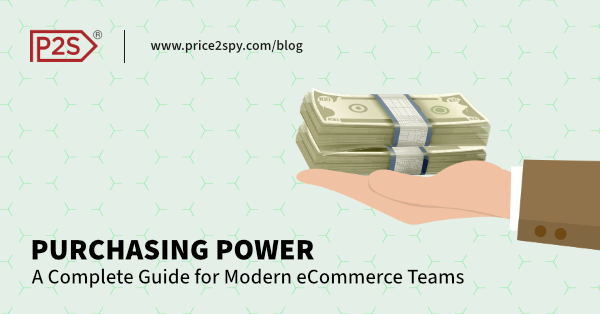
Purchasing Power | A Complete Guide for Modern eCommerce Teams
In simple terms, purchasing power represents:
- The real-world value of money;
- A measure what the money you own can do;
- The link between prices and the value of money.
If we were to go into a bit more detail, the textbook definition of purchasing power is: the amount of goods and/or services that a unit of currency can buy. It reflects the actual value of money. It is inversely related to the general price levels. This means that as the prices rise (inflation), the purchasing power falls, and vice versa.

In eCommerce, it measures the consumers’ ability to make online purchases while taking into account:
- price levels,
- income levels, and
- exchange rates (in international eCommerce).
Let’s see in more detail how this concept is relevant for eCommerce professionals, how it relates to other economic concepts (especially inflation), and what are its shortcomings and limitations.
Purchasing power in eCommerce
Purchasing power in eCommerce refers to the real ability of consumers to buy products online, shaped by their income levels, local prices, and cost of living. It determines how affordable your products feel to different customer segments. High purchasing power means customers can absorb price increases or premium offers. Low purchasing power means even small price differences can break conversions.
Why does understanding purchasing power matter for eCommerce businesses? It matters because it enables optimization of prices, segmentation, and marketing. Furthermore, it also makes deciding on whether to emphasize affordability or exclusivity, structuring product tiers, and discounts much easier.
Usually, eCommerce companies, and online retailers in particular, gauge purchasing power by looking at average order values, conversion rates, and regional income data.
Purchasing power in single-market eCommerce
Intuitively, you may think that purchasing power doesn’t matter when not doing eCommerce across borders. However, differences in income, cost of living, and price sensitivity exist across regions and customer segments. These differences need to be accounted for and prices and promotions need to be aligned with them. This makes it possible for companies to maintain sales volume and optimize profit margins.
Purchasing power parity (PPP)
Purchasing power parity (PPP) is a measure of the value of two or more currencies. It represents how much a basket of goods costs in different countries. In other words, it can tell someone from the United States, for example, how much goods a dollar can buy in other countries.
For eCommerce professionals this is important because it enables them to adjust their pricing not only based on the exchange rate, but also on what people can realistically afford. Furthermore, this helps balance competitiveness and profitability across markets. To illustrate this, here’s a simple example: if two countries have the same nominal price after currency conversion, but one has lower PPP, a product may feel overpriced there.
In practice, eCommerce professionals can use PPP data to define regional price indices for their product lines. In combination with local cost data, competitors’ prices, and conversion rates, this data can be used to set “fair” localized pricing tiers. This approach maintains consistency in perceived value worldwide, reduces cart abandonment in low-PPP regions, and signals pricing fairness. Many say this is the key to long-term brand trust and revenue stability.
TIP: If you are an eCommerce professional you can use the wide array of Price2Spy’s reports and dashboard widgets to measure, track, and compare your competitiveness, price indices, and more.
Purchasing power and inflation
Inflation is the primary factor that erodes purchasing power over time. As the general price level of goods and services increases, the real value of money decreases, reducing consumers’ ability to maintain previous consumption levels. Even moderate inflation can significantly alter purchasing behavior, shifting demand toward lower-cost alternatives or forcing consumers to postpone discretionary purchases.
Companies can manage these pressures by using continuous market monitoring and data-driven pricing models. They track inflation indices, competitor price changes, and shifts in customer spending to adjust prices, discounts, and product assortments in real time. Businesses that actively adapt to changing purchasing power maintain both competitiveness and financial stability in volatile markets.
Issues with purchasing power
While purchasing power is a core economic concept used to compare the real value of money across markets, it has several notable shortcomings. In practice, it simplifies complex consumer realities and can lead to misleading conclusions if applied without context. The following points outline key issues that limit its accuracy and practical use in modern markets, particularly within eCommerce.
Unequal market conditions
The concept of purchasing power assumes that consumers face similar prices and equal access to goods. In reality, regional costs, availability, and taxes vary widely. These differences distort how far a unit of currency can go, making purchasing power an uneven measure across markets.
Measurement inaccuracy
Accurately measuring purchasing power is difficult. Price indices depend on a fixed “basket of goods” that often fails to reflect real consumer behavior or industry-specific trends. As a result, reported changes in purchasing power may misrepresent actual affordability, particularly in fast-changing sectors like eCommerce.
Ignoring non-price value
Purchasing power focuses solely on monetary capacity and overlooks qualitative value. Two products with identical prices may differ greatly in quality, design, or utility—factors that strongly influence buying decisions. This limitation reduces the concept’s usefulness in understanding customer satisfaction, brand perception, or long-term loyalty.
Conclusion
Purchasing power remains one of the most practical yet misunderstood concepts in business. It links directly to how consumers perceive value, how inflation affects real spending, and how pricing decisions influence competitiveness. Its true usefulness depends on how well it reflects real market conditions across segments and over time.
For eCommerce companies, understanding both the strengths and limitations of purchasing power is essential. It helps determine when customers can genuinely afford an offer and when price adjustments are needed to maintain conversions. When applied thoughtfully, it becomes a foundation for smarter, fairer, and more sustainable pricing strategies.



